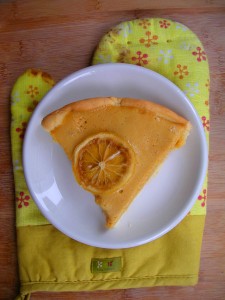Lemon pie is in a way the holy Graal of our kitchens – or at least mine. Even though it is the favorite dessert of a huge amount of people, we never agree on the recipe, and the ingredients can vary quite decisively : cream or butter ? flour or maizena ? egg or not ? And so on… But most of all, we never settle down for long to one recipe, even though we are first quite happy about it. Is it because of the acidic stimulation of the lemon that we keep on searching, eternally hesitating between sweet and sour ?
Anyway, even though I don’t delude myself on the fact that I will soon hit the road again of the wonder lemon world, here is a recipe of lemon pie that I am actually quite happy with.
Often with lemon pies, you sacrifice the texture for its taste or reverse. Personnally, I don’t like it when it is topped by a layer of meringue : too sweet, not yellow enough, you miss the point. In this recipe, no more hiding : taste and look are perfectly balanced, between the sweet and sour taste, creamy almost foamy consistency of lemon preparation, and the firm and crispy though soft material of the pastry dough.
For both, here is the secrets : arrow-root for the lemon cream, and yeast for the pastry. I encountered the first by making a Japanese style dessert, with a black sesame topping taken fromClea Cuisine blog. This thickening agent, easy to digest, made of a plant found in rainforests, is very much used in Japanese sweet cooking. It replaces perfectly well – even better I would say – corn starch, commonly known as “Maizena”. As for the dough, the recipe is inspired from another lemon-pie-knight, being Scally, author of the blog C’est moi qui l’ai fait. I followed all of the recommendations, except for the sugar (I put less) and the flour, as I felt like my dough was a still too humid with just 250 g of it.
But before heading to the cooking time, here is a zest of history, as I deeply believe narrative is a major ingredient to true savoring. Showing the path to its pie, lemon is a quite mysterious fruit from the Himalayas. It came to Europe in travelers’ bundles in the 12th century. It was then used both as food and medicament against scorbut (oignons and pruneaux d’Agen we also used). This is how it happened to be brought to America by Christopher Columbus itself in 1493. In the 17th century, along with the rising success of still life painting, it became the star of canvas, especially Dutch, for it offers the most interesting combination of texture and colors, with its skin in acidic yellow, topping a layer of matt white, and inside, a network of shining golden pulp.
Proud to be a lemon pie recipe
For about 8 persons
The dough
– 125 g of salted butter (room temperature, but not too soft)
– 100 g sugar
– 1 egg
– 350 g white flour
– ½ teaspoon baking powder
The lemon cream
– 3 lemons
– 1 egg
– 70 g sugar + 2 tablespoon to caramelize limn slices (I used brown sugar to give it a nice retro taste)
– 40 g arrow root
1. Begin with the dough
In a bowl, combine sugar, egg and butter until creamy. Add the sifted flour ad baking powder, mix well with your hand. Form a bowl, film it and let it rest in the fridge for 30min.
Grease your tin. Spread out the dough, not to thin. With a knife, cut it in the shape of your tin by covering your dough with it. Tuck it into the tin. With left oveers, form a bowl and spread it out one more time, to cut strips of 6-7 cm for the edges. Put it together with the bottom by pinching it. Here is some tips to do it nicely (and peacefully).
Cover with baking paper, and ballast it with marbles or dry beans (in Japan, I use rice, of course !) so that the dough stays nice and flat while baking.
Bake for about 10 minute turning temperature to 350 F (180 °C, thermostat 6). Then, take of the marbles and the baking paper and prolong the cooking for about 7 min, so that the dough turns lightly gold.
Remove from oven and let it cool. Take it out of the tin, you should be able to do it just by carefully flipping it over, using your hand to gently receive it. Place it on a serving plate.
2. Make the lemon cream
Press the juice out of your lemons. With your fingers or a mortar (Japanese ones are terrific for this), break the arrow root pieces to make a thin powder.
In a bowl, beat the egg with the sugar, mix well with a whisk until it turns white. Combine with arrow-root and lemon juice, mix well. If egg yolk particles appear on the surface, don’t worry, it will disappear during the cooking process by mixing it well.
In a saucepan, put the mixture over a brisk heat, continuously stirring it until it has the texture of a sauce béchamel. Use a spoon to make sure nothing sticks in the corners of your saucepan. Be careful, the thickening process is sudden and rapid.
Pour the cream over the dough. Let it rest, and when it has cooled, put in the fridge for about an hour.
Serve it along with a Lady Earl Grey tea.
In option : you can decorate it with some caramelised lemon slices.
Put a 4th lemon to boil in water. Let it boil during 5 min, drain, and let it cool, then cut it in 3 mm slices. In a non-stick pan, pour 2 table spoon of brown sugar and let it caramelized over a brisk heat (do not stir, it would make it fail). When blond, lay the lemon slices, let them suck the caramel and turn them upside down. Set aside and let them cool on a ceramic plate. Lay the lemon slices on the top of the pie, one per serve, so that, at the serving time, your knife does not meet with it.
See these other pies :
– Pear and almond pie, with a Japanese version
– Tarte tatin au Melon









